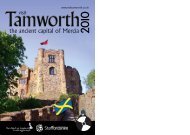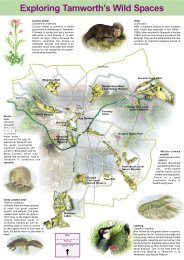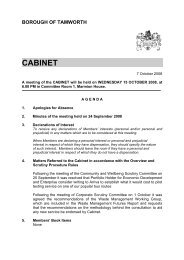Conservation Management Plan - Tamworth Borough Council
Conservation Management Plan - Tamworth Borough Council
Conservation Management Plan - Tamworth Borough Council
Create successful ePaper yourself
Turn your PDF publications into a flip-book with our unique Google optimized e-Paper software.
A widely promulgated theory is that early Norman Motte and Bailey castles might be deliberately sighted on former<br />
Saxon high status sites in order to slight them (Liddiard 2004:30). It has been suggested that <strong>Tamworth</strong> Castle might<br />
have been sited on the site of Offa’s palace (Meeson 2006:7).Wainwright dug in the bailey in 1960 to try and locate<br />
‘Offa’s Palace’ but found nothing conclusive, although he did not publish his results and the records, housed within<br />
the castle archives are piecemeal and tantalising. What survives of the Bailey remains an area of high archaeological<br />
significance, and the potential buried remains of Saxo-Norman timber buildings would be particularly fragile, so it<br />
must receive full protection in its management.<br />
As recently as 1966, scholars interpreted the herringbone masonry wall of the causeway leading up the motte as<br />
late Saxon (HM Taylor 1966) and others have suggested it was part of Offa’s palace, and that motte was built up<br />
against it. Herringbone masonry is widely used in churches, but it is not in itself diagnostic and it can be impossible<br />
to distinguish between pre-and post-conquest work.<br />
Meeson has provided a plausible, and widely accepted suggested location for the palace in the enclosure<br />
surrounding St Editha’s church (Meeson 1979: 22-30). However Blair, has suggested that many potential high<br />
status ‘palace’ sites, like Northampton and Cheddar may actually be high status religious houses, which provided<br />
hospitality to itinerant kings. It is entirely possible that the religious and secular high status sites at <strong>Tamworth</strong> were<br />
in separate enclosures, perhaps this is one interpretation of the large ditch running east west between Church<br />
Street and Market Street?<br />
St Editha’s Church<br />
Although none of the fabric of St Editha’s church is definitely pre-conquest there is little doubt that there was a<br />
church on this site in the Saxon period. The location of the church at the dead centre of the Saxon defences and<br />
within the smaller enclosure postulated by Meeson, makes it highly likely that there was an important Saxon church<br />
or monasterium here. In the medieval period the church was administered by a college of priests rather than by a<br />
single rector/vicar and was by the 14 th century a royal free chapel, both of which are indicative of an early status as a<br />
minster church from which priest s were sent out to preach in outlying areas before the establishment of the parish<br />
system. William Marmion, son of Robert Marmion III (the Justiciar) was Dean of St Editha’s in the mid 12 th century.<br />
The collegiate church of St Edith, was founded in the 10 th century, and had a full prebendal system introduced in<br />
the 1130s, by Roger de Clinton, Bishop of Coventry. There is confusion over which Editha the church was dedicated<br />
to. Roger of Wendover, writing in the 13 th century, is the source of this confusion. He wrongly stated that Editha,<br />
sister of Athelstan married Sihtric, king of Northumbrians and later founded a monastery at Polesworth, close to<br />
<strong>Tamworth</strong>. Earlier sources make it clear that Athelstan married his sister Editha to the Emperor Otto in 930 and that<br />
she died at Magdeburg in 946 as the recent identification of her body there reminds us.<br />
The nunnery at Polesworth may have been associated, with the church. Ninth century sources list Edgyth as abbess<br />
of an unknown nunnery. Gould has suggested that the most likely candidate is Edith sister of the West Saxon king<br />
Aethelwulf (839-858) an alternative is Edith the daughter of King Egbert, who founded Polesworth Abbey in 827. The<br />
most likely date for the dedication of the church to St Edith is the 12 th century when it was rebuilt by the Marmion<br />
family who also held churches with the same dedication at Polesworth and Pulverbatch. (Gould 1985-6; Meeson<br />
1979, 47-8).<br />
We don’t know what happened to the church in era of Danish invasions. The Viking army over-wintered at Repton,<br />
only 15 miles from <strong>Tamworth</strong> in 874-5, and the Mercian King Burghred was driven out and replaced by King<br />
Ceolwulf II who followed a policy of appeasement. In 877 the Mercian kingdom was divided between the Danes and<br />
king Ceolwulf.<br />
The Anglo Saxon chronicle tells us the kingdom of Mercia was ravaged at this time and it has been suggested that<br />
<strong>Tamworth</strong> was destroyed by the Danes. However there is no specific mention of this in the Anglo Saxon chronicle.<br />
It is possible that the first phase of the Town Ditch actually belongs to a Danish phase of occupation of the town<br />
(Shaw 2010), which is recollected by the Danish street names Gumpengate and Alldergate.<br />
In 913 <strong>Tamworth</strong> was retaken by Aethelflaed, and she died there in 918. A measure of its strategic importance as<br />
a place at this time, is that after Athelstan seized control of Mercia, the Saxon nobles gathered at <strong>Tamworth</strong> for a<br />
Great <strong>Council</strong> and declared Athelstan ‘King of all the English’. In 925 it was chosen to be the site of a peace treaty<br />
between Athelstan and the Danish King Sihtric of Northumbria at which time Sihtric married one of Athelstan’s<br />
sisters and briefly accepted the Christian faith.<br />
<strong>Tamworth</strong> Castle <strong>Conservation</strong> <strong>Management</strong> <strong>Plan</strong> www.marionblockley.co.uk<br />
Part 1<br />
27







